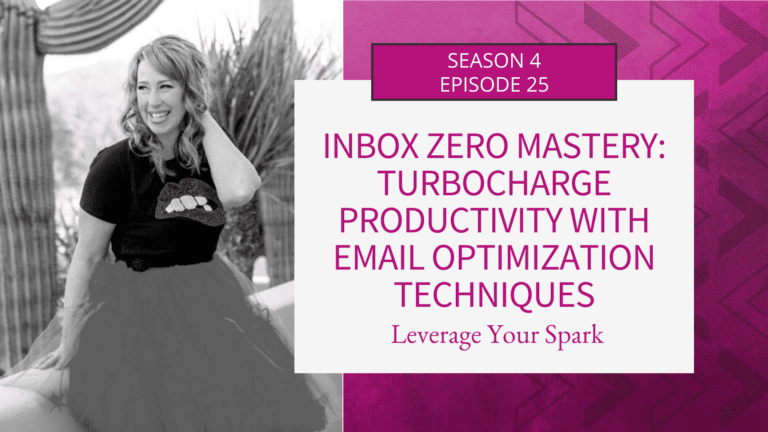Inbox Zero Mastery: Turbocharge Productivity with Email Optimization Techniques

I’ve been using email since 1995. That’s almost 30 years. The first form of email was created in 1971. That’s older than me and the modern internet. The world has had a lot of time to get used to using email and it is essentially the default communication method of business. Which is great because you can just say “I’ll email you” and everyone knows what that means. The flip side is that the world has evolved and there are much better systems and tools for sharing and managing information than email, but they are difficult to use if everything is stockpiled in your inbox. It is also challenging to manage your time & attention if you have to wade through your emails to figure out what you are supposed to be doing and where that file or piece of information went.
My email habits were one of the first self-sabotaging activities I had to re-form when I started running my own business. In my corporate jobs, living in your inbox was expected. Composing well-formed, long, data-laden emails was the “work.” Turns out, that isn’t really getting anything done and using that same way of working will kill a small business. Taking an hour to compose an email doesn’t create cash flow or delight clients.
Email still has its uses. But to-do list, relationship building, file transfer and project management are not good uses for email.
Email Optimization for Inbox Zero: Conquering Distractions and Maximizing Productivity
It gets a lot easier to get to inbox zero when you have places to put the information that comes into your inbox, and when the emails you are getting are worthy of your attention. Let me be clear, getting an empty inbox might not be the goal for you, but let me tell you why it was for me. I am easily distracted, especially when I want to be tackling important projects that might not be urgent, like finishing the book I’m writing or defining the strategy and outline for the next season of the podcast.
In those moments, all I had to do was open up my inbox and be carried away into a sea of distractions. If my inbox is empty, it is no longer a temptation to distract me. The other issue was even when I was in task-mode working on client projects or my to-dos, if the information I needed was in my inbox, I would get distracted by all the other messages in there. Some just to read again if it was good news. Others would trigger a pang of panic when I recalled that I hadn’t responded to a message yet or forgot there was another task on my list.
A collection of emails in my inbox was a productivity black-hole for me. So I decided to do something different.
Efficient Inbox Mastery: Streamlining Email Communication for Productivity and Focus
It has been a years-long, winding-road process to get to a place where I can have an empty inbox each day. In the hopes of short-cutting your journey if this is something you want too, here’s the method I use:
- Get the crap out – for too long I allowed emails into my inbox that I just deleted. Sure, it takes less than a second to delete an email, but it also takes my attention. And if I’m doing this many, many times a day – that is time, energy & attention wasted. The unsubscribe link is your friend, use it on anything you are just deleting in your inbox. This also goes for emails you are getting that are notifications from other systems. Listen to the last episode if notifications are filling your inbox.
- Create a schema for your information – anyone that’s talked to me in the last 45 days has probably heard me use this word. If you’re not familiar: schema is a framework for organizing and understanding information. What really held me back from having an empty inbox was not knowing where the information should go. Being scared of losing something and thus it got stuck in my inbox. Once I had defined a place for the information to live, it didn’t have to stay in my inbox. And no, this isn’t a 1-and-done process. This might start out being a review at the end of the week to see what is in your inbox. Then deciding or defining where that information goes.
- Stop sending internal emails. Really, at this point, if you are still communicating inside your company via email you need a better system. There are many to choose from. Reach out if you need help.
- Choose the right communication method – The better your communication, the less touchpoints that are needed. Nothing pains me more than seeing an 8-message email chain with 6 recipients that still has not resolved the question in the first email. 😭 Just because you can send an email, doesn’t mean that is the right communication channel. Don’t get me wrong, any communication channel can get misused, it isn’t just email. However, your path to an emptier inbox means choosing your communication method more wisely.
Maximizing Efficiency: Empowering Productivity Through Effective Inbox Management
Getting the right information in the right places has made me more efficient and effective. It has also increased the overall productivity and happiness of the team. Booting the overflowing inbox can be the first step to improving communication both inside and outside the organization. I now have more time, attention, and energy to dedicate to important tasks and projects in the business. An empty inbox enhances my effectiveness during work hours. Working fewer hours is possible due to the overall outcome of an empty inbox.
After talking about Email Optimization Techniques, the next episode is a wrap on season 4 and I’ll be talking about using systems to create consistency.
If you enjoyed this episode, you can head over to leverageyourspark.com to subscribe. Also please leave us a review or share with a friend. Everyone deserves to have less stress and more impact!

